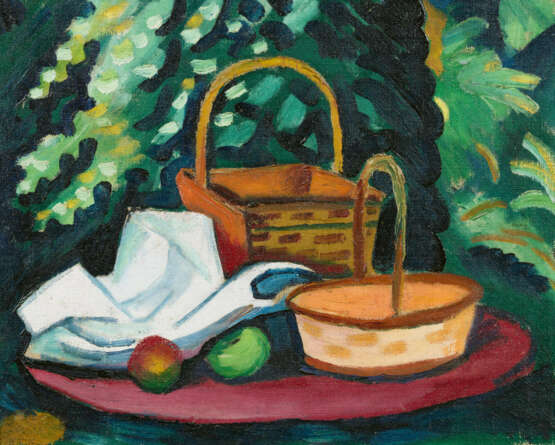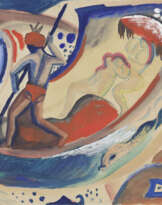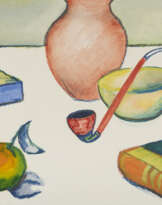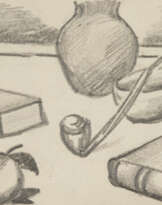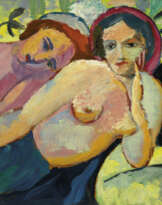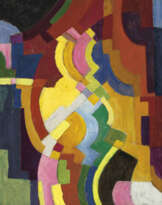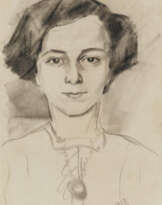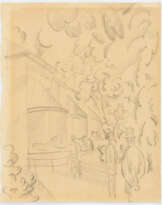ID 1337714
Лот 12 | August Macke.Stilleben mit Körben
Оценочная стоимость
€ 280 000 – 350 000
Title: Stilleben mit Körben.
Date: 1911.
Technique: Oil on canvas.
Measurement: 48 x 60,5cm.
Notation: Signed and dated right centre: Amacke 1911.
Frame/Pedestal: Framed.
Signed and dated right centre Amacke 1911. Verso inscribed by a hand other than that of the artist (presumably Wolfgang Macke): A. MACKE 1911 Stilleben mit Körben. Additionally inscribed by a hand other than that of the artist on the stretcher with title, date and Vriesen no. 252. Five estate stamps on the canvas and stretcher. Two round stamps on the canvas and stretcher, the lower one legible: Budapesten. Inscribed on top of the stretcher: B8786. Exhibition label: 48.
Provenance:
- Estate August Macke (stamp)
- Private collection (1957)
- Collection Dr. Walter Kaminsky, Düsseldorf (1958)
- Private collection Düsseldorf (1958)
Exhibitions:
- Galerie Thannhauser, Munich 1912
- Suermondt-Museum, Aachen 1948, cat. no. 26
- Braunschweiger Kunstverein, 1954, cat. no. 32
- Westfälischer Kunstverein/Westfälische Wilhelms Universität/Westfälisches Landesmuseum, Münster 1957, cat. no. 32
Literature:
- Gustav Vriesen, August Macke, Stuttgart 1953, p. 321, cat. rais. no. V 252, ill.
- Heiderich, Ursula: August Macke - Gemälde, Werkverzeichnis, Ostfildern-Ruit 2008, cat. rais no. 315, ill.
- Rare still life from a highly innovative period in his oeuvre, during which some of his strongest works were created
- In 1911, Macke joined the Munich artists' group "Der Blaue Reiter"
- The intensely colored and two-dimensional forms show the clear influence of Henri Matisse's painting at this time
Painted in 1911, "Stillleben mit Körben" was probably painted by Macke in his studio in Bonn, after his return from Southern Germany - a new and pivotal phase, when he critically reconsidered the influence of contemporary French painting on his art and elaborated his own individual pictorial vocabulary based on a unique synthesis of form and color.
In early 1908 Macke had started incorporating fauve motifs and analyzing Matisse's use of space and color. His second stay in Paris in 1908, and his third one there in 1909, gave him a deeper awareness of the contemporary avant-garde experiments. But the crucial debate about the expressive power of pure colors reached its climax only in 1910 when Macke, working at lake Tegernsee, spent a great deal of time with Franz Marc discussing the most recent developments in French contemporary painting. There, Macke did a series of sketches (Skizzenbuch No. 38, published in U. Heiderich, "August Macke, Die Skizzenbücher", Vol. II, Stuttgart, 1987, pp. 819-835) inspired by the German edition of Matisse's "Notes d'un peintre" (appeared in "La Grande Revue", Paris, Dec. 1908).
In February 1910, Macke travelled to Munich where he saw Matisse's works exhibited at the Thannhauser Gallery and was particularly impressed by a painting of 1904, "Saint Tropez, La Terrasse" (Boston, Isabella Stewart Gardner Museum), which he copied in his sketchbook (page 78 of Skizzenbuch No. 38) and re-elaborated in his painting "Unser Garten mit blühenden Rabatten" (1912, Private Collection).
Founded in 1911, Der Blaue Reiter included artists such as Franz Marc, Wassily Kandinsky, and Alexej von Jawlensky among its members and emphasized the manifestation of radiant colors in its work. However, Macke gradually distanced himself from the almost abstract, geometrically inspired compositions of Der Blaue Reiter and turned to a new, soft, and free-flowing style.
Macke's studio pictures executed in Bonn had a simplicity and at the same time a monumentality, which his colleagues from Der Blaue Reiter did not apply. He also began to develop a more dramatic approach to perspective, flattening its depths and using broad color planes, very much in line with Matisse's experiments of the same period. Macke's still lives from 1911 brilliantly reflect the artist's concern for compositions based on color planes in which the interest in ornament can be clearly identified and spatial values are defined by color.
Our painting 'Still Life with Baskets' shows this new compositional style: Dominating light green and dark colors of a tree, in front of a sharply cropped light source in a garden landscape, lend the painting a magically suggestive depth. Contrasting in complementary colors, the two baskets, two apples, and the white cloth are positioned on a blood-red circular plate. The tabletop seems to float, liberated from gravity, above a blue-white-black fluid. Macke also dispenses with the shading in the perspective design of the tablecloth, as is known in classical painting, and replaces the folds with contour lines, much in the spirit of Matisse. Macke has consistently applied this new type of perspective design since 1911, and it continues to gain recognition, as evidenced by auction results.
The still life (fig. 1) auctioned at Sotheby's in February 2008 has much in common with our painting. Outlines reflect perspectives, the apple bowl threatens to fall of the table, and the Japanese fan is supported by a green void.
Our painting can be dated to the second half of 1911, when Macke primarily turned to canvas as a medium in his Bonn studio. Although a prepared cardboard produces a deeper resonance of the colors used, this was no longer necessary in view of the new compositional style. The still life auctioned at Christie's in London in October 1999 (fig. 2) illustrates this change. Presumably created at the beginning of 1911, Macke used a cardboard as a support for his painting.
The colors appear richer, and Macke still creates spatial depth through the arrangement of objects, but clear contour lines are already an essential design element. While still more traditional here, a few months later Macke joins the avant-garde with our still life "Stillleben mit Körben" and also with "Stilleben mit Äpfelschale und Japanischem Fächer".
Amongst the German painters of the early period of the twentieth century, Macke was certainly amongst the most daring and the keenest to argue that he had his own personal painting idiom.
| Автор: | Август Макке (1887 - 1914) |
|---|---|
| Техника исполнения: | Масло |
| Категория аукционного дома: | Модернистские картины, рисунки, акварели |
| Автор: | Август Макке (1887 - 1914) |
|---|---|
| Техника исполнения: | Масло |
| Категория аукционного дома: | Модернистские картины, рисунки, акварели |
| Адрес торгов |
VAN HAM Kunstauktionen GmbH Hitzelerstr. 2 50968 Köln Германия | ||||||||||||||
|---|---|---|---|---|---|---|---|---|---|---|---|---|---|---|---|
| Предосмотр |
| ||||||||||||||
| Телефон | +49 221 92586215 | ||||||||||||||
| Факс | +49 221 92 58 62 4 | ||||||||||||||
| Комиссия | 32% | ||||||||||||||
| Условия использования | Условия использования | ||||||||||||||
| Часы работы | Часы работы
|
